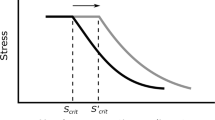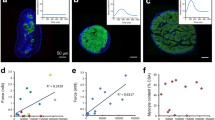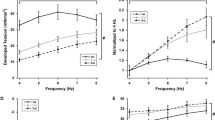Abstract
Multicellular cardiac muscles are widely used to study cardiac (patho-)physiology in vitro. One of the potential pitfalls of such experiments is that muscles with a large diameter have a larger diffusion barrier for transport of oxygen and waste products and can thus potentially form a hypoxic core. Although a sufficiently small muscle size is critical for obtaining unambiguous data, the relationship between muscle diameter and contractile performance specifically under near-physiological conditions remains unknown. Small uniform trabeculae of various diameters isolated from LBNF1 rats were stimulated at different temperatures (27.5–37.5°C) and frequencies (1–8 Hz). Twitch contractions and rapid cooling contractures were used to assess contractile performance and SR Ca2+ load, respectively. We observed that at physiological frequencies and temperatures, contractile performance was clearly diminished in muscles with diameter >150 μm, likely due to the decreased rates of oxygen supply and waste removal. At room temperature slower contractions allow sufficient time for oxygen diffusion into the muscle core, and as a result the difference in contractile performance between the thin and thick muscles was less. Thus, in order to exclude adverse effects on contractile performance in multicellular myocardium under physiological conditions, it is essential that the preparations are of sufficient small diameter (<0.15 mm).




Similar content being viewed by others
References
Backx PH, Ter Keurs HE (1993) Fluorescent properties of rat cardiac trabeculae microinjected with fura-2 salt. Am J Physiol Heart Circ Physiol 264:H1098–H1110
Bers DM (1987) Ryanodine and the calcium content of cardiac SR assessed by caffeine and rapid cooling contractures. Am J Physiol 253:C408–C415
Blinks JR, Koch-Weser J (1963) Physical factors in the analysis of the actions of drugs on myocardial contractility. Pharmacol Rev 15:531–599
Bridge JH (1986) Relationships between the sarcoplasmic reticulum and sarcolemmal calcium transport revealed by rapidly cooling rabbit ventricular muscle. J Gen Physiol 88:437–473
de Tombe PP, ter Keurs HE (1990) Force and velocity of sarcomere shortening in trabeculae from rat heart Effects of temperature. Circ Res 66:1239–1254
Janssen PML, Hasenfuss G, Zeitz O, Lehnart SE, Prestle J, Darmer D, Holtz J, Schumann H (2002) Load dependent induction of apoptosis in multicellular myocardial preparations. Am J Physiol Heart Circ Physiol 282:H349–H357
Janssen PML, Hunter WC (1995) Force, not sarcomere length, correlates with prolongation of isosarcometric contraction. Am J Physiol Heart Circ Physiol 269:H676–H685
Janssen PML, Stull LB, Marban E (2002) Myofilament properties comprise the rate-limiting step for cardiac relaxation at body temperature in the rat. Am J Physiol Heart Circ Physiol 282:H499–H507
Kentish JC, ter Keurs HE, Ricciardi L, Bucx JJ, Noble MI (1986) Comparison between the sarcomere length–force relations of intact and skinned trabeculae from rat right ventricle Influence of calcium concentrations on these relations. Circ Res 58:755–768
Koch-Weser J, Blinks JR (1963) The influence of the interval between beats on myocardial contractility physical factors in the analysis of the actions of drugs on myocardial contractility. Pharmacol Rev 15:601–652
Kogler H, Hartmann O, Leineweber K, Nguyen van P, Schott P, Brodde OE, Hasenfuss G (2003) Mechanical load-dependent regulation of gene expression in monocrotaline-induced right ventricular hypertrophy in the rat. Circ Res 93:230–237
Layland J, Kentish JC (1999) Positive force- and [Ca2+]i-frequency relationships in rat ventricular trabeculae at physiological frequencies. Am J Physiol Heart Circ Physiol 276:H9–H18
Lecarpentier Y, Waldenstrom A, Clergue M, Chemla D, Oliviero P, Martin JL, Swynghedauw B (1987) Major alterations in relaxation during cardiac hypertrophy induced by aortic stenosis in guinea pig. Circ Res 61:107–116
Mulieri LA, Hasenfuss G, Ittleman F, Blanchard EM, Alpert NR (1989) Protection of human left ventricular myocardium from cutting injury with 2,3-butanedione monoxime. Circ Res 65:1441–1449
Schouten VJ, ter Keurs HE (1986) The force–frequency relationship in rat myocardium The influence of muscle dimensions. Pflugers Arch 407:14–17
Stull LB, Leppo M, Marban E, Janssen PML (2002) Physiological determinants of contractile force generation and calcium handling in mouse myocardium. J Mol Cell Cardiol 34:1367–1376
Stuyvers BD, McCulloch AD, Guo J, Duff HJ, ter Keurs HE (2002) Effect of stimulation rate, sarcomere length and Ca(2+) on force generation by mouse cardiac muscle. J Physiol 544:817–830
ter Keurs HE, Rijnsburger WH, van Heuningen R, Nagelsmit MJ (1980) Tension development and sarcomere length in rat cardiac trabeculae Evidence of length-dependent activation. Circ Res 46:703–714
Acknowledgements
This study was supported by the National Institutes of Health (NIH) grant RO1 HL073816—01A1 and AHA National Center Grant SDG 0235045 N (PMLJ).
Author information
Authors and Affiliations
Corresponding author
Rights and permissions
About this article
Cite this article
Raman, S., Kelley, M.A. & Janssen, P.M.L. Effect of muscle dimensions on trabecular contractile performance under physiological conditions. Pflugers Arch - Eur J Physiol 451, 625–630 (2006). https://doi.org/10.1007/s00424-005-1500-9
Received:
Revised:
Accepted:
Published:
Issue Date:
DOI: https://doi.org/10.1007/s00424-005-1500-9




